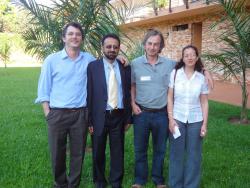Project 6: Targeting
 Project Title
Project Title
|
An examination of ACT strategy in south-central Asia on falciparum malaria in a context where P. vivax is the major species. |
Project Location(s)
| Kabul, Nangahar and Kunduz, Afghanistan |
Lead Principal Investigator
|
Dr. Mark Rowland, LSHTM Background in malaria control and research in the context of conflict and complex emergencies, particularly in Asia. Starting life as a medical entomologist Mark soon realized that no malaria control programme can neglect the problem of drug resistance or the need for effective chemotherapy. In addition to the drug resistance he works on problems associated with insecticide resistance in malaria vectors |
Other Principal Investigators
|
Chris Whitty - London School of Hygiene and Tropical Medicine Toby Leslie - London School of Hygiene and Tropical Medicine Amy Mikhail - London School of Hygiene and Tropical Medicine Ismail Mayan - Health Protection and Research Organization (HPRO, Kabul) Nader Mohammed - HealthNet-TPO (Kabul) Fayaz Ahmed - Medical Emergency Relief International (Merlin, Kabul) Hugh Reyburn - London School of Hygiene and Tropical Medicine |
Research Aim(s)
Project Background and Rationale
|
With the exception of Sub-Saharan Africa, most areas that are endemic for malaria have a combination of two species, Plasmodium falciparum and P. vivax. P. vivax is often the dominant species. Because the two species differ in their severity and susceptibility to commonly used drugs, diagnosis is crucial to effective targeting of treatment. The more dangerous P. falciparum is often resistant to cheap antimalarials where P. vivax is still susceptible. The recommended drugs for P. falciparum can be more than ten times as expensive as those that are effective against P. vivax. Coupled to this are the transmission levels of the two diseases, which are often much lower than the force of transmission in Africa. For this reason most people in vivax predominant regions with fever do not, in fact, have malaria. As transmission levels drop, a lesser proportion of fever cases will have malaria parasites as the cause of their illness. Former polices of treating all fever cases with cheap antimalarial drugs are now obsolete. Diagnosis is unavailable in most places, and one solution is the use of rapid diagnostic tests (RDT). These can be seen as a relatively cost-effective method of administering diagnosis in areas of low and mixed endemicity. However, their effectiveness is only assured if the result of the test is adhered to. Evidence from Africa shows that even when diagnosis is available, many patients who do not have malaria are still given an antimalarial. Where two species coexist, the situation is even more complicated. We aim to test the effectiveness of different diagnostic and treatment systems and measure the impact of each on the effectiveness of treatment. This will also help to determine whether, in areas of low transmission, accurate treatment and diagnosis, coupled with other preventative measures can provide enough pressure on the disease to eliminate it passively. |
Current Status of Project
|
In 2010, an observational study was completed which evaluated the effectiveness of current diagnosis in 22 Afghan clinics in targeting treatment. The study showed that the era of clinical diagnosis, where no laboratory diagnosis is available for malaria, is now unsupportable and results in less than 10% of patients being effectively targeted with appropriate treatment for fever. A second trial, conducted in 2010 and 2011 examined the effect of malaria rapid diagnostic tests in improving targeting of treatment. The RDTs proved much more effective than clinical diagnosis, but did not improve the targeting of treatment when compared to microscopy - around 50% of patients who did not have malaria were treated with an antimalarial despite the result. In the current phase of the project a cluster randomised study is underway to evaluate the use of malaria rapid diagnostic tests amongst community health workers when deployed at village level health posts. The trial's first phase began in November 2011 and will provide data on the effectiveness and cost-effectiveness of the RDTs used at community level. |

